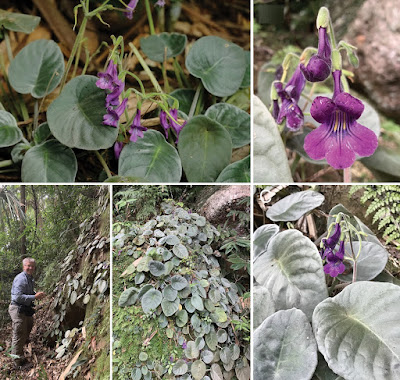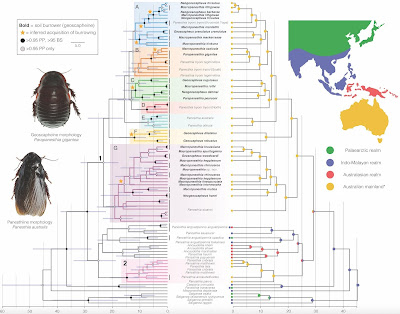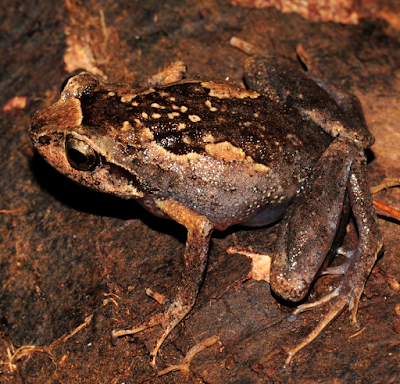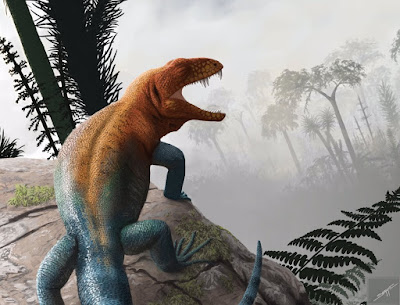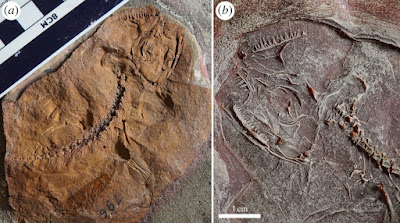[Most Recent Entries] [Calendar View]
Monday, May 17th, 2021
| Time | Event | ||||||||
| 6:46a | [Botany • 2021] Chayamaritia vietnamensis (Gesneriaceae) • A New Species from Son La Province, northern Vietnam
Abstract Chayamaritia vietnamensis, a new species from Son La Province, northern Vietnam, is described and illustrated. The phylogenetic study revealed that the new species is most closely related to C. banksiae and C. smitinandii. The morphological comparison suggests it as the third new species of Chayamaritia and distinguished from C. banksiae and C. smitinandii by a combination of morphological characters of leaf blades, bracts, calyx and corolla, especially its peltate leaf blades. This species is provisionally assessed as endangered (EN B1ab(iii), B2ab(iii)) using IUCN Categories and Criteria. Information on ecology, phenology and an identification key for the known Chayamaritia species are also provided. Keywords: Cliff-dwelling, Flora of Vietnam, new taxon, taxonomy Chayamaritia vietnamensis F.Wen, T.V.Do, Z.B.Xin & S.Maciej, sp. nov. Diagnosis: The new species can be easily distinguished from the known Chayamaritia species by its peltate leaf blades. Besides, it differs from C. banksiae by its leaf blades apex rounded and margin entire (vs. apex shortly acuminate and margin minutely dentate); bracts 3, apex rounded and margin entire (vs. 2, apex acuminate and margin dentate); calyx lobes inside glabrous and margin entire (vs. inside with white appressed hairs in upper half, margin coarsely dentate); corolla lobes margin entire (vs. margin being minutely dentate); lateral staminodes 2.5–4 mm long (vs. 5.5–11 mm long). It also differs from C. smitinandii by its leaf blades apex rounded and margin entire (vs. apex acuminate and margin minutely dentate); bracts 3, ovate narrow and apex rounded (vs. 2, narrowly elliptic to lanceolate, somewhat falcate, apex acuminate); calyx lobes inside glabrous and margin entire (vs. inside densely pubescent, margin slightly toothed or appearing as large sessile glands on margin). Etymology: The specific epithet “vietnamensis” is derived from Vietnam, which holds the first discovered and only known location for the species. Distribution and habitat: Chayamaritia vietnamensis is hitherto only known from the type locality, Xuan Nha Nature Reserve, Moc Chau District, Son La Province, northern Vietnam. It grows on rock surfaces surrounded by limestone areas in a subtropical evergreen seasonal rain forest. Zi-Bing Xin, Long-Fei Fu, Stephen Maciejewski, Zhang-Jie Huang, Truong Van Do and Fang Wen. 2021. Chayamaritia vietnamensis (Gesneriaceae), A New Species from Son La Province, northern Vietnam. PhytoKeys. 177: 43-53. DOI: 10.3897/phytokeys.177.63401 | ||||||||
| 8:18a | [Entomology • 2021] Digging Deep: A revised Phylogeny of Australian Burrowing Cockroaches (Blaberidae: Panesthiinae, Geoscapheinae) Confirms Extensive Nonmonophyly and Provides insights into Biogeography and Evolution of Burrowing
ABSTRACT Soil‐burrowing cockroaches (Blaberidae: Geoscapheinae) are large insects endemic to Australia. Originally thought to represent a monophyletic group, these enigmatic species have in fact evolved burrowing behaviour, associated fossorial morphological modifications, and dietary transitions to dry leaf litter feeding multiple times from the wood‐feeding Panesthiinae in a striking example of parallel evolution. However, various relationships within these two subfamilies remain unresolved or poorly understood, notably the apparent paraphyly of Panesthiinae with respect to Geoscapheinae, the position and diversification of certain species within major clades, and several aspects of the overall group's biogeography and morphological evolution. Here, we investigate the phylogeny of Australian members of these two subfamilies using whole mitochondrial genomes paired with nuclear ribosomal markers and highly conserved genes from the bacterial endosymbiont Blattabacterium. Using the resulting robust, fossil‐calibrated phylogeny from these three sources we confirm the nonmonophyly of both subfamilies and recover Geoscapheinae as polyphyletic within a paraphyletic Panesthiinae. The nonmonophyly of natural groups, at all levels from subfamily to species, has been driven by repeated, independent acquisitions of burrowing forms in Geoscapheinae from panesthiine ancestors that colonized the continent on two separate occasions during the Miocene. We additionally find morphological variation within Geoscapheinae itself is correlated with species distributions. Older soil‐burrowing clades living in comparatively arid environments have additional morphological reductions beyond obvious fossorial adaptations compared to those in younger burrowing clades from more temperate habitats. Ultimately, the results presented here demonstrate connections among phylogeny, biogeography and morphology throughout Australian representatives of these two subfamilies, factors that could not be previously consolidated using existing phylogenetic frameworks. Given the discordance between molecular data implemented here and the existing taxonomic classification, we find no support for retaining Geoscapheinae as a discrete taxonomic grouping. In closing, we discuss the taxonomic implications of these results and present a roadmap for future research on Geoscapheinae and their panesthiine relatives. Conclusions: The results of this study are consistent with ancestral Asian wood‐feeding lineages of Panesthiinae dispersing to Australia at least twice, with one of those colonization events giving rise to soil‐burrowing cockroaches presently classified as Geoscapheinae. We find that soil‐burrowing has evolved at least seven times from this ancestral state and that the diversification of burrowing forms was ongoing from approximately 17–3 Mya. These transitions were likely driven by bursts of aridification the Australian continent experienced beginning ∼25 Mya, and this parallel evolution of burrowing traits in geoscapheines has rendered soil‐burrowing associated morphology alone phylogenetically misleading. Within Geoscapheinae, we demonstrate additional character reductions have occurred related to reproductive and tergite morphology in clades that diverged from their panesthiine ancestors earlier and inhabit more arid biomes compared to younger burrowing clades found in more temperate environments. We also identify a distinction between panesthiines with putatively plesiomorphic traits that have close soil‐burrowing relatives compared to those with more ‘geoscapheinae’‐like morphology that are nested within, or gave rise to, geoscapheine clades. Ultimately, our revised phylogenetic framework is reflective of both biogeography and morphology of these species, and this is the first time such factors have been unified in the context of the evolutionary history of these insects. Given this new phylogenetic evidence, we propose the morphology and habitat preferences of Geoscapheinae no longer warrant subfamilial status for the group. Perry G. Beasley‐Hall, Harley A. Rose, James Walker, Yukihiro Kinjo, Thomas Bourguignon and Nathan Lo. 2021. Digging Deep: A revised Phylogeny of Australian Burrowing Cockroaches (Blaberidae: Panesthiinae, Geoscapheinae) Confirms Extensive Nonmonophyly and Provides insights into Biogeography and Evolution of Burrowing. Systematic Entomology. DOI: 10.1111/syen.12487 | ||||||||
| 8:37a | [Herpetology • 2015] Rhombophryne longicrus • Leaping towards A Saltatorial Fifestyle? An Unusually Long-legged New Species of Rhombophryne (Anura, Microhylidae) from the Sorata Massif in northern Madagascar
Abstract The Madagascar-endemic microhylid genus Rhombophryne consists of a range of partly or completely fossorial frog species. They lead a poorly known, secretive lifestyle, and may be more diverse than previously thought. We describe a new species from the high altitude forests of the Sorata massif in north Madagascar with unusual characteristics for this genus; Rhombophryne longicrus sp. n. has long, slender legs, unlike most of its fossorial or semi-fossorial congeners. The new species is closely related to R. minuta, a much smaller frog from the Marojejy massif to the southeast of Sorata with similarly long legs. We discuss the morphology of these species relative to the rest of the genus, and argue that it suggests adaptation away from burrowing and toward a more saltatorial locomotion and an accordingly more terrestrial lifestyle. If this is the case, then these frogs represent yet more ecological diversity within the already diverse Cophylinae. We recommend an IUCN Red List status of Endangered B1ab(iii) for R. longicrus sp. n., because it is known only from a single site in a forested area of roughly 250 km2, which is not yet incorporated into any protected area. Key Words: Rhombophryne longicrus sp. n., Integrative taxonomy, Rhombophryne minuta, Osteology, Cophylinae, X-ray micro-computed tomography
Rhombophryne longicrus sp. n. Diagnosis: A microhylid assigned to the genus Rhombophryne on the basis of overall morphology, including the possession of maxillary and vomerine teeth, absence of expanded toe pads, and absence of an enlarged prepollex. Confirmed as a member of the genus Rhombophryne on the basis of its phylogenetic relationships as assessed by mitochondrial DNA, as there are no known morphological characters by which Rhombophryne may be distinguished from Plethodontohyla. Rhombophryne longicrus sp. n. is distinguished from all other Madagascan frog species by the following set of characters: SVL 23.8–27.9 mm, head wider than long, horizontal tympanum diameter 47% of eye diameter, absence of superciliary spines, weak supratympanic fold, dark supratympanic region and nostril, tibiotarsal articulation reaching the nostril, total hindlimb length 183–185% of SVL, second finger shorter than fourth, and fifth toe shorter than third. It is also separated by a pairwise genetic distance of at least 6.8% in the 16S mitochondrial gene from all other known species of the genus Rhombophryne. ... Distribution: This species has only been found at high altitude in the montane forests of the Sorata massif in north Madagascar. Its distinctiveness leads us to hypothesize that it has never been found elsewhere and misidentified, so it may be microendemic to this small area. Additional surveys are required in areas in and around Sorata to identify its full distribution. Ecology: Both specimens described here were captured in the early evening on the ground along a path through primary montane forest. The stomachs of both specimens contained remains of several small insects (mostly Coleoptera) and a spider (possibly belonging to the family Salticidae), mixed with moss, suggesting an opportunistic diet of arthropods. Calls of this species are unknown. The female holotype had more than twenty immature oocytes with the largest having diameters ranging from 1.3 to 1.6 mm. As a member of the Cophylinae, it is likely that R. longicrus lays its eggs away from running water or large water bodies, and has endotrophic tadpoles. Etymology: The species epithet is an invariable noun in apposition to the genus name, derived from the Latin words longus (meaning long), and crus (meaning leg), and refers to the unusually long legs of this species.
Mark D. Scherz, Andolalao Rakotoarison, Oliver Hawlitschek, Miguel Vences and Frank Glaw. 2015. Leaping towards A Saltatorial Fifestyle? An Unusually Long-legged New Species of Rhombophryne (Anura, Microhylidae) from the Sorata Massif in northern Madagascar. Zoosystematics & Evolution 91(2): 105-114. DOI: 10.3897/zse.91.4979 Burrowers playing leapfrog? An extraordinary new diamond frog from Madagascar | ||||||||
| 10:25a | [Paleontology • 2019] Carbonodraco lundi • the Oldest Parareptile (Amniota: Parareptilia), from Linton, Ohio, and New Insights Into the early Radiation of Reptiles
Abstract Redescription of the holotype specimen of Cephalerpeton ventriarmatum Moodie, 1912, from the Middle Pennsylvanian (Moscovian) Francis Creek Shale of Mazon Creek, Illinois, confirms that it is a basal eureptile with close postcranial similarities to other protorothyridids, such as Anthracodromeus and Paleothyris. The skull is long and lightly built, with large orbits and a dorsoventrally short mandible similar to most basal eureptiles. Two specimens referred previously to Cephalerpeton cf. C. ventriarmatum from the approximately coeval Linton, Ohio, locality differ significantly from the holotype in cranial and mandibular proportions and tooth morphology. This material and an additional Linton specimen compare favourably to ‘short-faced’ parareptiles, such as Colobomycter and Acleistorhinus, and justify recognition of an acleistorhinid parareptile in the Linton assemblage. The new binomen is thus the oldest known parareptile. Keywords: Pennsylvanian, Amniota, Carboniferous, Mazon Creek, Parareptilia, Eureptilia Subjects
Systematic palaeontology Tetrapoda Jaekel, 1909 Amniota Haeckel, 1866 Parareptilia Olson, 1947 Acleistorhinidae Daly, 1969 Carbonodraco gen. nov. Carbonodraco lundi sp. nov. =Cephalerpeton cf. C. ventriarmatum Reisz and Baird 1983 Etymology: Generic name derived from the Latin words ‘Carbo’ (coal), and ‘Draco’ (serpent). Specific name is in honour of Dr Richard Lund, who found the holotype.
Arjan Mann, Emily J. McDaniel, Emily R. McColville and Hillary C. Maddin. 2019. Carbonodraco lundi gen et sp. nov., the Oldest Parareptile, from Linton, Ohio, and New Insights Into the early Radiation of Reptiles. Royal Society Open Science. 6 (11): 191191. DOI: 10.1098/rsos.191191 |
| << Previous Day |
2021/05/17 [Calendar] |
Next Day >> |
